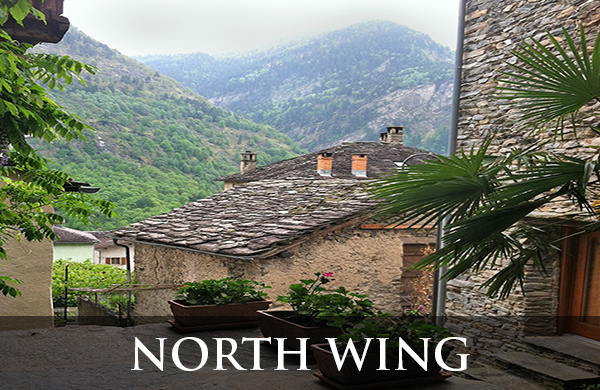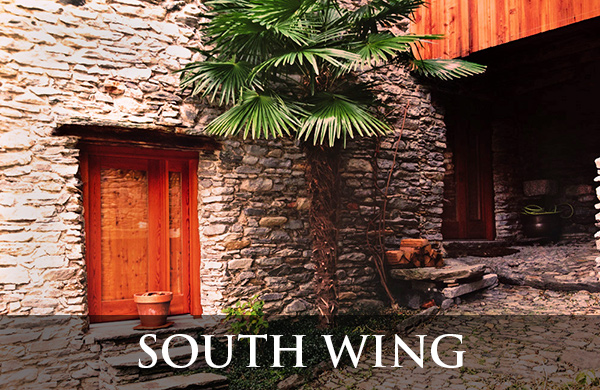Cimavilla 1335:
A Restored 18-room Medieval Patrician Casa in Italian-speaking Switzerland
Soazza, Mesolcina Valley, Switzerland
Cimavilla 1335 is an 18-room Medieval Patrician Casa of historic and cultural significance in Italian-speaking Switzerland. It is an elegant, historic alpine residence in the “Swiss Mediterranean.” The property is situated in the village of Soazza in the Mesolcina Valley, an alpine valley bordering Bellinzona, the capital of Ticino, to the south of the Valley. To the north of Soazza, the San Bernardino tunnel and ski area are 15 miles away via motorway A13/E43. Cimavilla has been carefully restored with the help of Swiss local, canton, and national governments, and it is a protected property under the Hague Convention in times of armed conflict.
Soazza is alpine sub-tropical with abundant sun, clean air, palm, fig, and chestnut trees, as well as vineyards, alpine peaks, and rushing waters. Its proximity to the Swiss-Italian lake district means Lakes Como, Lugano, Maggiore, and Varese are less than an hour’s drive. Prestigious Swiss alpine ski resorts are 1.5 hours by car.
As one of the most privileged locations in Europe, it has the benefits of Swiss infrastructure, and nearby motorway A13/E43 make it an easy drive to other parts of Switzerland as well as Italy and Germany. Lugano airport is 45 minutes and Milano airports are 90 minutes by car, and Zurich is 2.25 hours by car.
Mesolcina Valley
The Italian-speaking part of Switzerland is famous for its beautiful valleys. Mesolcina with its Italian language and customs is, by an accident of history, in Grisons canton, but it borders and is considered part of Bellinzona in Ticino. Ticino as the southernmost canton of Switzerland borders Italy, and has a sub-tropical climate where the sun shines 300 days a year, giving it the term “Swiss Mediterranean.” Bellinzona is a UNESCO heritage site with its three restored castles, and it has a pedestrians-only city center.
Mesolcina Valley traces back to Roman times and was even inhabited in Prehistoric times. Charlemagne descended the Valley in 774 AD, and Barbarosse met his cousin Henry the Lion in battle here. During Medieval times, the castles at Bellinzona (as well as the Mesocco Castle at Soazza) controlled the most-important transalpine route between Italy and points north.
Soazza Village
Soazza has its beginning in the 12th century. Cimavilla itself is circa 1335 at least. Soazza has a sub-tropical climate with abundant sun, clean air, and palm, fig, and chestnut trees, as well as vineyards, alpine peaks, and rushing waters. Proximity to the Swiss-Italian lake district means that Lakes Como, Lugano, Maggiore, and Varese are less than an hour’s drive away.
Soazza is the jewel of the Mesolcina Valley. With a population of only 350, it has two churches. San Martino Church (1219/1626 restored) sits on a promontory overlooking the Valley, has a world-class organ, and is lighted at night and is seen from the Valley below and from Cimavilla. San Rocco Church (1419/1633 restored) and the Ospizio di Soazza (1639/2006 restored), a former Capuchin monastery are likewise protected by the Hague Convention in the event of armed conflict. Soazza has four private residences, including Cimavilla, also protected by the Hague Convention.
Soazza looks north 2 km. to Mesocco Castle (1481) which, like San Martino church, is lighted at night for travelers along the Valley floor and it too is seen from Cimavilla.
Cimavilla 1335: Patrician Casa, North Wing, and South Wing
Cimavilla’s four stories cascade down into Soazza Village. Though other homes are around Cimavilla, Cimavilla is quiety and private, and the views from Cimavilla are 360 with Mesocco Castle to the north; stone roofs, mountain passes to Italy, and churches San Martin and San Rocco to the east; and a panorama of alpine peaks to the north, east, south, and west.
Restored from 2000 to 2010 under auspices and support from the Grisons Monuments Commission, radiocarbon dating of beams has determined dates of 1335, 1565, and 1710 for parts of Cimavilla. Its special architectural interests include:
- original stone construction and granite roofs conserved
- a 1710 covered wooden bridge connecting the north and south parts of Cimavilla (“passerella”)
- a Romeo & Juliet balcony off the living room
- a wood-paneled Baroque patrician library with granite radiant stove
- a custom-designed contemporary wooden staircase to the master bedroom; and
- contemporary kitchens and baths.
As part of the conservation process, the Owner configured Cimavilla as 1) a Patrician Casa for his personal use (10 rooms), 2) a North Wing apartment with separate entrance for his family and guests (3 rooms), and 3) a South Wing apartment with separate entrance for his family and guests (2 rooms). Additionally there are: a wine/storage cellar, a laundry/utility room, a small room with separate street entrance to use as an office, attic/storage, and a small garden with plantings in four areas, including palm trees.




